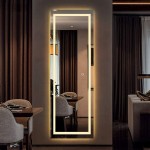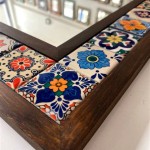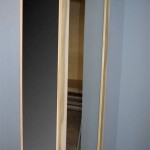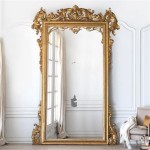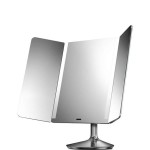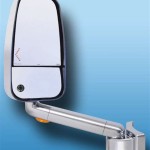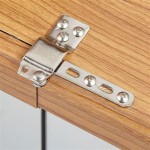Heavy Mirror Hanging Brackets: A Comprehensive Guide
Hanging a heavy mirror securely requires careful consideration of the mounting hardware. Standard picture hooks and nails often lack the strength and stability needed to support the substantial weight of larger mirrors, potentially leading to damage or, more concerningly, a dangerous fall. Heavy mirror hanging brackets are specifically designed to address this issue, providing a robust and reliable solution for safely mounting mirrors of significant size and weight. These brackets encompass a range of designs and weight ratings, each tailored for specific installation scenarios and mirror dimensions.
The selection and installation of appropriate heavy mirror hanging brackets constitute a critical aspect of interior design and safety. It is crucial to thoroughly assess the weight of the mirror, the structural integrity of the wall, and the type of bracket best suited for the application before proceeding with installation. A properly chosen and installed bracket system will ensure the mirror remains securely mounted, enhancing the aesthetic appeal of the room while minimizing the risk of accidents.
Understanding the Types of Heavy Mirror Hanging Brackets
A variety of heavy mirror hanging brackets are available, each with its own advantages and disadvantages. Understanding these differences is crucial for selecting the appropriate bracket for a specific mirror and wall type. The following are some common types of heavy mirror hanging brackets:
Z-Bar or French Cleat Hangers: Z-bar hangers, also known as French cleats, are among the most popular choices for hanging heavy mirrors and artwork. They consist of two interlocking metal pieces that create a strong, secure connection. One piece is mounted to the wall, and the other is attached to the back of the mirror. The angled design of the interlocking pieces distributes the weight evenly, making them ideal for supporting heavy loads. Z-bar hangers are particularly useful because they allow for slight horizontal adjustments after the mirror is hung, ensuring the mirror is perfectly level. Installation typically involves screwing the wall-mounted cleat into wall studs or using appropriate anchors for drywall. The mirror-mounted cleat needs to be affixed securely to the back of the mirror using screws and adhesive.
Heavy-Duty D-Rings with Wire: D-rings are small, metal rings with a flat base that are attached to the back of the mirror. These connect to a strong wire or cable that is then hung on a sturdy hook or bracket mounted on the wall. While D-rings are commonly used for lighter mirrors, heavy-duty versions are available for larger mirrors as well. When using D-rings, it is important to use two D-rings spaced apart on the back of the mirror, connected by a heavy-gauge wire. The wire should be rated to support several times the weight of the mirror to ensure a safe and secure installation. The wall-mounted hook or bracket must also be capable of supporting the weight. Unlike Z-bars, D-rings do not allow for easy horizontal adjustment after hanging, so precise placement during installation is essential.
Plate Hangers (Adapted for Mirrors): While traditionally used for hanging decorative plates, some plate hangers can be adapted for use with mirrors, particularly those with a lip or frame that can accommodate the hanger's prongs. These hangers typically feature a spring-loaded mechanism that grips the sides of the plate or mirror, providing a secure hold. However, it's crucial to select plate hangers specifically rated for the weight of the mirror. These are best suited for mirrors with a defined lip or edge on the back and might not be suitable for frameless mirrors or mirrors with unconventional shapes.
Mirror Mounting Clips: Mirror mounting clips are typically used for frameless mirrors. These clips are designed to hold the mirror securely against the wall. The clips come in various designs, including top and bottom clips, side clips, and L-shaped clips. The number of clips required will depend on the size and weight of the mirror. Mirror mounting clips are often made of plastic or metal and are attached to the wall using screws and anchors. Proper installation requires precise measurements to ensure the mirror is level and secure. Some clips have rubber or felt padding to prevent scratching the mirror surface. These clips often offer a more minimalist aesthetic since they are designed to be less visible.
Heavy-Duty Angle Brackets: Angle brackets, typically L-shaped, offer simple but strong support when properly installed. These brackets attach to the wall with screws and support the mirror from underneath. They are often used in conjunction with other types of hangers for added support or when the mirror is resting on a vanity or shelf. For heavy mirrors, it’s important to use angle brackets made of thick metal with a high weight rating. These brackets are typically concealed behind the mirror or integrated into the surrounding structure for a clean look.
Factors to Consider When Choosing Brackets
Selecting the right heavy mirror hanging brackets involves careful assessment of several factors. These factors include the weight and dimensions of the mirror, the type of wall, and the desired aesthetic. Overlooking these factors can lead to an unsafe or unstable installation.
Mirror Weight and Dimensions: The weight of the mirror is the most critical factor in selecting the appropriate brackets. Always check the weight rating of the brackets and choose ones that can safely support the mirror's weight with a significant margin of safety. The dimensions of the mirror also play a role. Larger mirrors require more support points to prevent warping or sagging. For very large mirrors, consider using multiple sets of brackets spaced evenly along the top edge or using a combination of bracket types for added support.
Wall Type and Construction: The type of wall is another crucial consideration. Different wall types require different types of anchors and mounting hardware. Drywall, plaster, and concrete walls each have different load-bearing capacities and require specific installation techniques. For drywall, it's essential to locate wall studs and use screws that penetrate deep into the stud for maximum support. If studs are not available in the desired location, use heavy-duty drywall anchors rated for the weight of the mirror. For plaster walls, use anchors specifically designed for plaster, as standard drywall anchors may not hold securely. Concrete walls require the use of masonry drill bits and concrete anchors. Proper installation is critical to ensure the brackets are securely attached to the wall and can support the weight of the mirror.
Aesthetic Considerations: While functionality is paramount, aesthetic considerations should also be taken into account. The type of brackets chosen can affect the overall look of the installation. Z-bar hangers are relatively concealed, while mirror mounting clips are more visible. Consider the style of the mirror and the room when selecting brackets. For a minimalist look, consider using frameless mirror clips or concealing Z-bar hangers behind the mirror. For a more decorative look, you can choose brackets with an ornate design or finish.
Adjustability and Ease of Installation: Some brackets offer more adjustability than others. Z-bar hangers, for example, allow for slight horizontal adjustments after the mirror is hung, making it easier to level the mirror. Other types of brackets may require more precise measurements and installation. Consider your skill level and the complexity of the installation when choosing brackets. If you are not comfortable with DIY projects, it may be best to hire a professional to install the mirror.
Material and Durability: The material and durability of the brackets are important factors to consider, especially for long-term use. Choose brackets made of high-quality materials that are resistant to rust and corrosion. Steel and aluminum are common choices for heavy-duty brackets. The finish of the brackets should also be durable and resistant to scratching or fading. Consider the environment in which the mirror will be installed. If the mirror is in a bathroom or other humid environment, choose brackets that are specifically designed to resist moisture.
Proper Installation Techniques for Heavy Mirror Hanging Brackets
Even the best heavy mirror hanging brackets will fail if not installed correctly. Proper installation requires careful planning, accurate measurements, and the use of appropriate tools and techniques. The following are some key considerations for installing heavy mirror hanging brackets:
Preparation and Planning: Before starting the installation, gather all the necessary tools and materials. This includes the brackets, screws, anchors, a level, a measuring tape, a pencil, a drill, and a screwdriver. Read the manufacturer's instructions for the brackets carefully and plan the installation step-by-step. Determine the desired location for the mirror and mark the position of the brackets on the wall. Use a level to ensure the brackets are aligned properly. Consider the location of wall studs and plan to use them whenever possible for maximum support. If studs are not available, choose appropriate drywall or plaster anchors rated for the weight of the mirror.
Wall Stud Location and Anchoring: Locating wall studs is crucial for a secure installation, especially for heavy mirrors. Use a stud finder to identify the location of the studs. Mark the stud locations on the wall with a pencil. When installing brackets, align the screw holes with the stud locations and use screws that are long enough to penetrate deep into the stud. If studs are not available in the desired location, use heavy-duty drywall or plaster anchors. Follow the manufacturer's instructions for installing the anchors. Drill the appropriate size hole and insert the anchor. Make sure the anchor is securely seated in the wall before attaching the bracket. For concrete walls, use a masonry drill bit to drill holes and use concrete anchors designed for the weight of the mirror.
Leveling and Alignment: Leveling and alignment are critical for a professional-looking installation. Use a level to ensure the brackets are perfectly horizontal. If the brackets are not level, the mirror will appear crooked. Use a measuring tape to ensure the brackets are spaced evenly and aligned vertically. Double-check the measurements before drilling any holes. If using Z-bar hangers, make sure the two pieces of the cleat are aligned properly so they can interlock securely. If using mirror mounting clips, ensure the clips are positioned to hold the mirror securely against the wall without putting excessive pressure on the edges.
Securing the Mirror to the Brackets: Once the brackets are installed on the wall, carefully lift the mirror and attach it to the brackets. If using Z-bar hangers, align the mirror-mounted cleat with the wall-mounted cleat and gently lower the mirror into place. If using D-rings and wire, hang the wire on the wall-mounted hook or bracket. If using mirror mounting clips, slide the mirror into the clips and tighten the screws to secure it in place. Double-check that the mirror is securely attached to the brackets and that it is level. Gently push on the mirror to test its stability. If the mirror feels loose or unstable, remove it and recheck the installation of the brackets.
Safety Precautions: Safety should always be a top priority when installing heavy mirror hanging brackets. Wear safety glasses to protect your eyes from debris. Use a ladder or step stool to reach high places and make sure it is stable and secure. Ask for assistance when lifting heavy mirrors to prevent injuries. Disconnect the power supply before drilling into walls to avoid electrical shock. If you are not comfortable with DIY projects or if you are unsure about any aspect of the installation, it is best to hire a professional to install the mirror.

Heavy Picture Mirror Hanging Kit 50 Kg

Heavy Duty Large Picture Mirror Hanging Kit 50kg Hook D Ring Set

Heavy Duty Mirror Hanging Hardware Kit With Hangers Leveling 100 Lbs

50 Kg Heavy Duty Mirror Hanging Kit Secure Large Picture Frame Hooks Hangers Fittings For

How To Hang A Heavy Mirror C R F T

Simple Mount 30 In Heavy Duty Mirror And Picture Hanger Hm 30d The Home Depot

Hangman Silver Mirror Picture Hanging Kit 300 Lb Com

How To Hang A Heavy Mirror With Pictures Wikihow

Heavy Duty Flush Mounts Fitting Slide Interlocking Pic Sisi Ltd

Taskar Heavy Duty Picture Mirror Hanger Z Bar With Easy Level 450mm Diy At B Q

